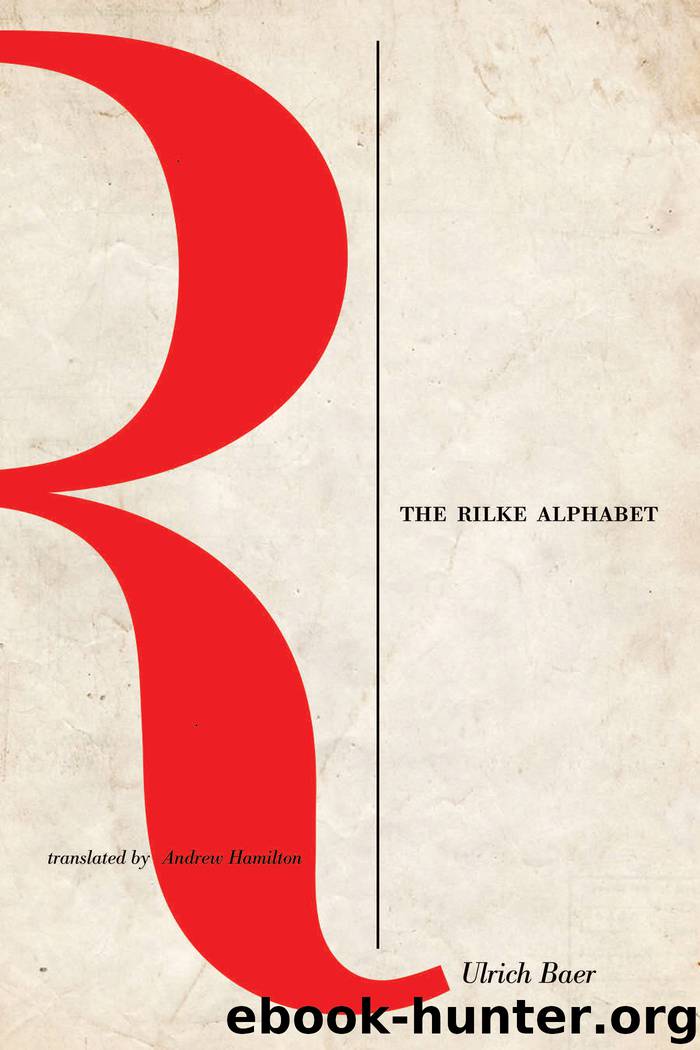The Rilke Alphabet by Baer Ulrich; Hamilton Andrew;

Author:Baer, Ulrich; Hamilton, Andrew;
Language: eng
Format: epub
Publisher: Fordham University Press
Published: 2014-04-06T04:00:00+00:00
n
for Nature
“Never nowhere without the No” (“und niemals Nirgends ohne Nicht”), it says in “The Eighth Elegy,” in which Rilke focuses on the difference between human and animal.1 All of the elegies seek a space where we can be truly ourselves, since we are woefully lost in a universe with strangely elusive, angelic messengers of redemption in whose embrace we would instantly “expire.” Animals live in such a “pure space” without concepts, expectations, and projections. Man, on the other hand, recognizes the world around him only when he can conceptualize it with the aid of thought. We, as humans, are aware of the constraint of death and see everything as if in reverse, from this final limit of what we can know. For us there is always only the world, which Rilke understands as the surroundings as they are grasped (and experienced, not merely mediated) by our bodies, language, and consciousness. A “never nowhere without the No” would be a utopian, “unseparated” space of pure possibility, extending around us free of concepts, desire, or calculation. Such a space exists according to Rilke only for very young children and for animals, who live in a world without longing and for whom there is no such thing as past and present, only the “pure condition.” The world in which we live is for Rilke a product of our self-conception and self-determination, on which we rely to give meaning to everything. What we long for is a moment of respite from this world that is not the stillness of death but unmediated nature as experienced by children and animals.
Philosophers such as Martin Heidegger, Maurice Blanchot, and Giorgio Agamben have interpreted Rilke’s “The Eighth Elegy” as a treatise about the ontological difference between human and animal. According to Agamben, “Heidegger returns to this concept and traces a summary genealogy of it. That it arose out of the eighth Duino Elegy was, in a certain sense, obvious; but in being adopted as the name of being
[…] Rilke’s term undergoes an essential reversal, which Heidegger seeks to emphasize in every way”.2 Maurice Blanchot, on the other hand, praises Rilke for considering the existence of “never nowhere without the No” for animals and children: “they play for hours and even lose themselves in the game, for this is the space of wandering.”3 But these readings turn Rilke’s poem into a philosophical tract (which ultimately fails the strict philosophical standards applied by Heidegger and Agamben in their respective analyses). Rilke’s formulation of the animal most likely refers back to Nietzsche. Placing the principle of reflection as the basis of human existence, Rilke’s insight into the difference between subject and object is, as another critic notes, “not fundamentally new.”4 For Rilke’s formulation of nature can be traced to the Romantic poets, for whom space, after the departure of religion in our disenchanted and enlightened age, can only reemerge as space through the application of human consciousness—as, for instance, in the explicitly a-religious and unscientific genre of landscape poetry, where
Download
This site does not store any files on its server. We only index and link to content provided by other sites. Please contact the content providers to delete copyright contents if any and email us, we'll remove relevant links or contents immediately.
The Rules Do Not Apply by Ariel Levy(4537)
Bluets by Maggie Nelson(4281)
Too Much and Not the Mood by Durga Chew-Bose(4104)
Pre-Suasion: A Revolutionary Way to Influence and Persuade by Robert Cialdini(3986)
The Motorcycle Diaries by Ernesto Che Guevara(3795)
Walking by Henry David Thoreau(3696)
What If This Were Enough? by Heather Havrilesky(3205)
Schaum's Quick Guide to Writing Great Short Stories by Margaret Lucke(3201)
The Daily Stoic by Holiday Ryan & Hanselman Stephen(3116)
The Day I Stopped Drinking Milk by Sudha Murty(3110)
Why I Write by George Orwell(2782)
The Social Psychology of Inequality by Unknown(2776)
Letters From a Stoic by Seneca(2677)
A Short History of Nearly Everything by Bryson Bill(2514)
Insomniac City by Bill Hayes(2404)
Feel Free by Zadie Smith(2384)
A Burst of Light by Audre Lorde(2354)
Upstream by Mary Oliver(2279)
Behave: The Biology of Humans at Our Best and Worst by Robert M. Sapolsky(2183)
